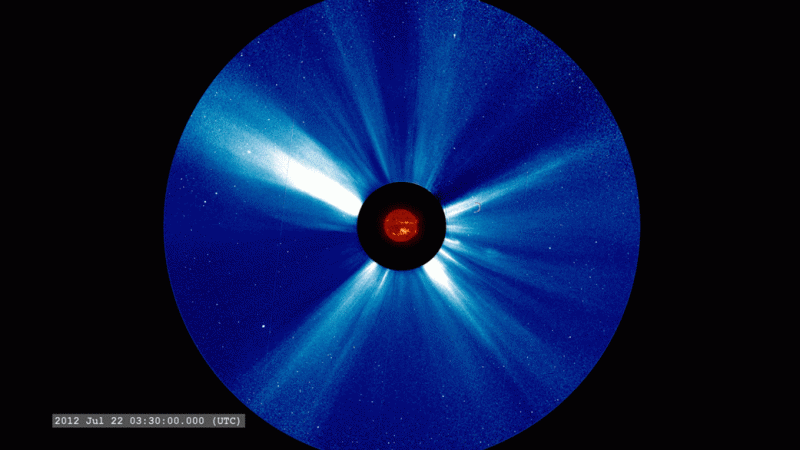How to read a STEREO image

In the same way that two eyes give humans a three-dimensional perception of the world around us, the twin spacecraft of NASA's Solar Terrestrial Relations Observatory mission, or STEREO, enable us to understand the sun in 3-D. Thanks to this mission, which launched on Oct. 25, 2006, we can see and study the sun from multiple viewpoints – crucial for understanding solar activity and the evolution of space weather.
One of STEREO's key instruments is called a coronagraph, which is used to study the corona, the sun's outer atmosphere. Each of STEREO's coronagraphs has a metal disk called an occulting disk. The occulting disk blocks the sun's bright light and makes it possible to discern the detailed features of the surrounding corona, which is about one million times dimmer than the sun. Much like the way the bright headlights of a semi-truck at night hide just how big the truck is, the brightly shining sun makes it difficult to study the much fainter corona.
In celebration of the mission's 10th anniversary, here is a guide to reading a STEREO image. Watch the video below, created with imagery of a massive July 2012 coronal mass ejection, to learn the key features of STEREO coronagraph data.
Space, in color
Each STEREO spacecraft has two coronagraphs with occulting disks of different sizes. The colors you see in the image are not true to life; scientists color the images to quickly tell which instrument in particular the image is from. In this video, the coronagraph image is colored blue.
Occulting disk
The black circle in the center of the coronagraph image is the occulting disk, which blocks the disk of the sun. The occulting disk mimics a total solar eclipse seen from Earth, in which the moon perfectly blocks the sun and allows observations of the massive corona.
The sun, in extreme ultraviolet light
Sometimes STEREO coronagraph images incorporate imagery from another one of STEREO's instruments called the Extreme UltraViolet Imager, which captures the sun in a type of light that is invisible to human eyes. Later, these images are colorized. These extreme ultraviolet light images are sometimes imposed over the occulting disk to help give a sense of the sun's size and position, and to provide more information as to which direction a solar eruption is headed. Extreme ultraviolet light images highlight active regions on the sun – regions where intense magnetic activity can give rise to solar eruptions. Here, STEREO observed the CME bursting forth from this active region.
Stars
Stars are often present in STEREO coronagraph images. These are the steady, brightly shining specks in the background.
Diffraction patterns
Faint ripples around the edge of the occulting disk result from diffracted light. When light enters the telescope, it hits the edge of the metal disk and bends, or diffracts, around the disk.
Streamers
Radial structures flowing out from the corona are called streamers. Solar material in streamers and the corona flow out into space to form the solar wind that fills our solar system.
Coronal mass ejections
Coronal mass ejections are eruptions of solar material that shoot far out into space, often accelerating particles ahead of them to near-light speeds. On July 23, 2012, STEREO-A saw this CME – one of the fastest on record. Scientists call this sort of CME a halo CME because the solar material forms a complete ring around the sun.
High-energy particle snow
As the CME expands beyond STEREO's field of view, a flurry of what looks like snow floods the image. These are high-energy particles flung out ahead of the CME at near-light speeds, striking the charge-coupled device in STEREO's camera. The immediacy and intensity of this "snowstorm" in space following the CME reflects just how fast and strong the eruption is: Less than an hour after the start of this eruption, accelerated particles traversed approximately 93 million miles from the sun to STEREO.
Provided by NASA





















